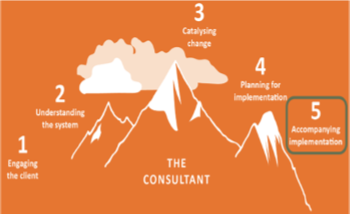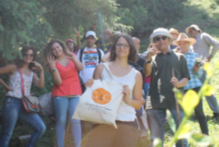By Nicole Titera.
I’m not sure many people get to say that they do their dream job but I am one of the lucky few that fall into this category. With funding from the NAMA Foundation, over the past 18 months I have managed the Consultants for Change (C4C) Programme. I have had the privilege of working with 38 aspiring and established civil society consultants from six countries as well as a plethora of talented facilitators and mentors from across the INTRAC network to make the programme a reality.
 C4C is a flag-ship programme on localising capacity building support and at the heart of the content is the Mountain Module for Change developed by Dr Rick James. It’s a framework for understanding the process of change and how, as consultants, we can support an organisation to genuinely learn and improve – something that the C4C participants have really picked up and run with!
C4C is a flag-ship programme on localising capacity building support and at the heart of the content is the Mountain Module for Change developed by Dr Rick James. It’s a framework for understanding the process of change and how, as consultants, we can support an organisation to genuinely learn and improve – something that the C4C participants have really picked up and run with!
At the beginning of July 2017, the C4C Kyrgyzstan participants and staff in INTRAC’s Central Asia office welcomed the whole C4C cohort to Lake Issyk Kul for the last face-to-face training.
The final intensive five-day training focused on accompanying implementation and concluding a consulting relationship to genuinely inspire change in a client organisation. Participants also put into practice newly honed writing techniques to develop case studies to be included in the next edition of the Consulting for Change core text. We are so excited that the participants get to reshape the programme materials based on their experiences and contexts. We hope to make the second edition widely available by the end of 2017 as well as translations into Russian and Arabic – so watch this space and keep an eye on INTRAC’s website.
One of the most energising sessions over the course of the week was how to develop a consultancy business plan and exploring models for future collaboration among the consultant group. While it may sound a bit dry, the participants’ enthusiasm to develop plans about how to share the core C4C principles – the idea of consulting with commitment, competence and character – in their own countries, was infectious. For me it is really inspiring to see the participants picking up the ideas and theories learnt through the programme, adapting them and making tangible plans to share knowledge, skills and experiences.
While understanding change is important, we also appreciated that giving participants the opportunity to strengthen existing specialism would be useful. Evaluations will be an important area of work for many of the C4C consultants, so with that in mind we offered a four-day workshop on Monitoring and Evaluation for Change following straight on from the final core C4C module.
 The highlight for me were the Most Significant Change and Impact Grid sessions. The techniques were explained by Alison Napier (INTRAC Monitoring and Evaluation lead) and Anne Garbutt (INTRAC Fellow) who facilitated the whole workshop. The participants put their learning into practice using the C4C programme as a case study. They reflected on “a significant change that has happened in their lives since joining the C4C programme” and then together went through a process of selecting the most significant stories and later mapped these onto an impact grid. In terms of work satisfaction it doesn’t get much better than hearing about how different elements of the programme you’ve made happen have influenced people’s approach to their work and lives.
The highlight for me were the Most Significant Change and Impact Grid sessions. The techniques were explained by Alison Napier (INTRAC Monitoring and Evaluation lead) and Anne Garbutt (INTRAC Fellow) who facilitated the whole workshop. The participants put their learning into practice using the C4C programme as a case study. They reflected on “a significant change that has happened in their lives since joining the C4C programme” and then together went through a process of selecting the most significant stories and later mapped these onto an impact grid. In terms of work satisfaction it doesn’t get much better than hearing about how different elements of the programme you’ve made happen have influenced people’s approach to their work and lives.
It’s not just during the face-to-face modules that I have had the chance to connect with the ‘C4Cers’. Between the three face-to-face modules the participants have applied their learning through practical work and written assignments as well as interacting through INTRAC’s online learning platform. The most recent written assignment asked the participants to reflect deeply on who they are and how this informs the way they work. I had the pleasure of reading these submissions about their journeys.
One of the participants from Palestine worked with Bill Crooks, one of the lead facilitators of the programme, to transform some of the key elements in her written assignment into a powerful digital narrative. You can delve into Bisan’s powerful story of a how a young girl’s experience of living under Israeli occupation shaped her choices and future plans to become a consultant committed to civil society development:
There was such fantastic energy on every day of the training and from each participant throughout the programme. The logistical headaches that inevitably come along with a large multi-country training programme have faded into background and what I am left with is a real sense that people want to put their learning into practice and share their skills and knowledge. That for me is more than I could have hoped for when setting out on this journey 18 months ago. It’s bittersweet that this chapter is coming to close, but I am excited to see how C4C changes and what happens next…
As part of NAMA’s legacy of support, INTRAC is developing an online course based on this successful C4C model! Sounds like something your organisation might want to do? Get in touch with Nicole Titera via info@intrac.org to find out more.
This blog was originally published on INTRAC Newsletter August 2017.